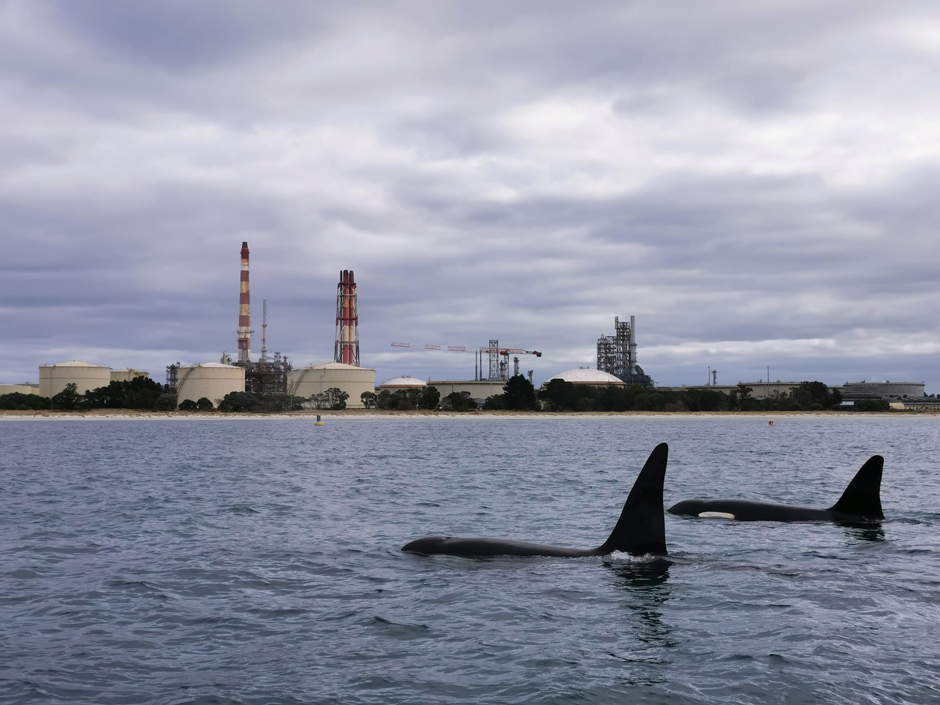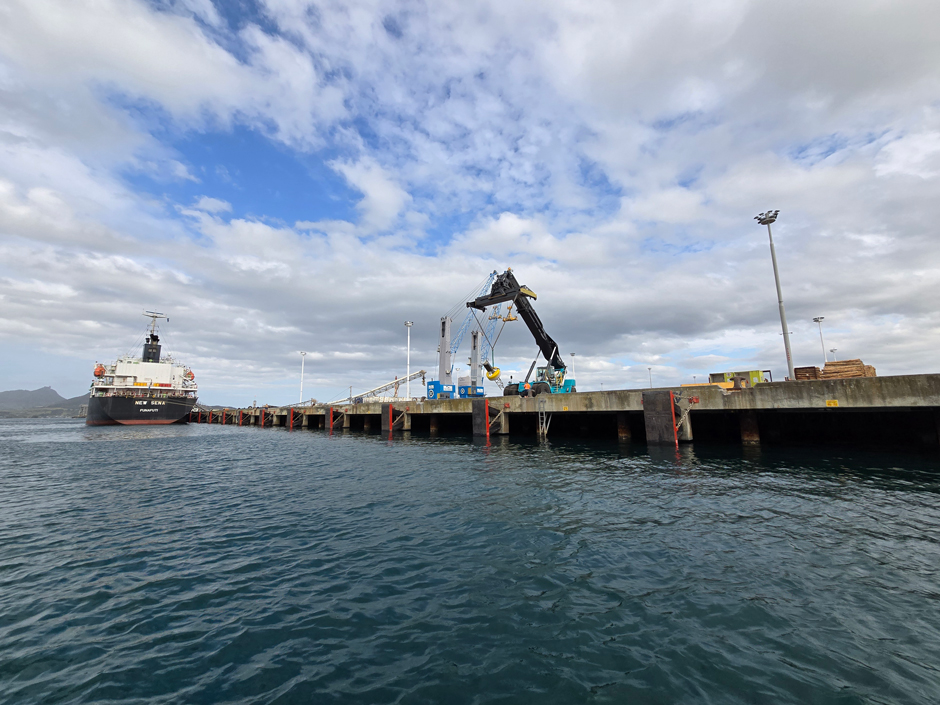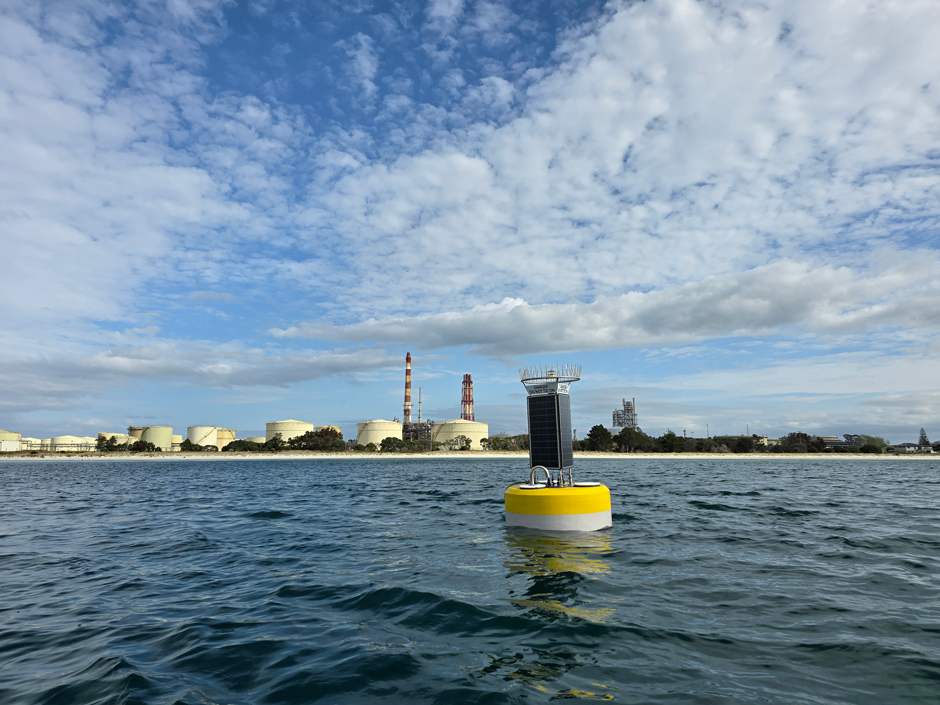Have You Heard? AI Buoys Revolutionizing Marine Mammal Monitoring in Whangārei Harbor, New Zealand
In one history, Whangārei Harbor, nestled in the lush hills of New Zealand’s North Island, gets its name from the Māori, “waiting for the breastbone of the whale.” It seems fitting, then, that it’s now home to state-of-the-art acoustic monitoring buoys listening for marine mammals around the clock.
In September 2024, a team from Auckland-based underwater acoustics firm Cetaware Ltd installed NexSens buoys in Northport, a major commercial port at the entrance to the Whangārei Harbor.
The first buoys to be installed by Cetaware in a permanent setting running 24/7, they use real-time artificial intelligence (AI) models to passively sense Delphinidae–from common dolphins to orcas.
Dr. Matt Pine, Director at Cetaware explains that for a busy shipping hub like Northport, data is key, stating, “People can, in real-time, obtain really important and accurate data on the presence of marine mammals in the waterways, data on soundscapes or vessel movements, 24/7 day or night, which can be used to inform real-world environmental management decisions.”

Orcas passing a buoy in Whangārei Harbor. (Credit: Ingrid N. Visser / Orca Research Trust)
Evolving Monitoring in Whangārei Harbor
Initially installed for a three-month pilot, Pine explains that the technology was the natural evolution of monitoring systems in Whangārei Harbor.
“Since 2020, the port has maintained several hydrophones around their operational zones to monitor the presence of cetaceans,” he says.
The hydrophone systems needed regular maintenance to deal with problems like batteries running out and memory cards filling up. They also recorded rather than transmitted, causing analysis bottlenecks as data was only obtained once the loggers had been retrieved. These problems are all solved in the new, real-time Cetaware system.
Deploying the New Cetaware Buoy Systems in Whangārei Harbor
Building and deploying a bespoke system housed in a NexSens buoy was straightforward. According to Pine, “NexSens provided the dimensions for the lid, which we had made up here locally. As soon as the buoy arrived, we could essentially just put the lid in because it’s all standardized. So whether it’s the 450s or the 1250s or the 950s, the lids are the same.”
Utilizing the Northport harbor team’s knowledge of tides and currents, moorings were built for the Cetaware buoys. The crane at the container terminal was used to hoist the buoys into the water before being towed to their permanent locations.
The buoys use edge processing, meaning data is processed inside the buoy and only transmits when it identifies sounds it has been told to listen for. In the case of the Cetaware buoys in Whangārei Harbor, they’re listening for frequencies above 1 kHz–the vocalizations of dolphins, orcas, and potentially humpback whales. When a vocalization is detected, audio is transmitted to a mobile device in real-time.
For Pine, the passive nature of this type of monitoring makes it special. “There’s something I really like about the idea of when an animal comes into a bay and it vocalizes, it’s made its presence known on its terms.”
“It [the buoy] doesn’t interact with the animal. It doesn’t have any impact on them. It just sits passively, and they’re providing information to you in a way. If it doesn’t vocalize, I don’t know what’s there–that’s the caveat to passive acoustics,” he says.

A crane lifts a buoy into the water as the first stage of deployment begins. (Credit: Credit: Cetaware Ltd)
Reaping the Benefits of Real-Time Monitoring Systems
Compared to manual loggers, the new real-time buoy system is more cost-effective, reducing labor, maintenance, and operational costs.
Pine explains that the buoys can be left out on the water for several months: “The NexSens buoys are pretty insensitive to fouling on the floats themselves, so it’s just knocking it over to its side and then getting the weeds off the hydrophone element.”
Furthermore, the buoys’ connectivity makes pushing software upgrades as easy as “a few keyboard strokes.” With systems like the NexSens CB-1250, the ability to remotely access the buoy means updating its models, troubleshooting issues, and applying upgrades can be done from anywhere in the world.
“Because it’s sending data back to our servers here on land, we can retrain those models periodically on the data obtained from it, and then during its midnight handshakes, ping it back. Then, when the sun rises, it’s running a whole new model. So as the technology evolves, as AI models change […] you don’t need the buoy back, we can push updates out to sea,” Pine explains.
This flexibility enables scalability. With multiple buoys across New Zealand running AI models, they can all improve using data from the Cetaware buoys, and vice-versa.
Applications of Acoustic Monitoring Data
Real-time data gathered by Cetaware’s system has already shed light on the behavior of marine mammals and is being practically applied.
“Port companies can better manage ship movements in and out of their ports. Pilots can slow vessels down if whales or dolphins are inside the harbor at the same time as their large ship is moving through the area, thereby affording those cetaceans more protection than they may have had otherwise,” Pine highlights.
Additionally, triangulation using three or four hydrophones means it’s possible to locate a vocalizing animal’s location. Pine explains that since deployment, there’s been a lot of activity recorded, and a surprising finding has been discovering how many marine mammals enter Whangārei Harbor at night.
The buoys can also monitor noise levels, creating a valuable archive that maps humans’ acoustic impact on the marine world.
The team hopes that data from the Cetaware system can contribute to the Department of Conservation’s sighting database, a key source used by decision-makers to determine whether an area is important for marine mammals.
The 24/7 data from the buoys helps build a more complete picture of animal activity in this area, free from the sampling bias commonly seen in datasets solely compiled from human observations.
Despite the limitations to observations, sightings remain important and–alongside corroboration from other sensors–are how the Cetaware system is being validated. Through this, the team now knows that the buoys can reliably hear Delphinids within 2km.

Buoys listening for marine mammals in Whangārei Harbor. (Credit: Cetaware Ltd)
What’s Next for Acoustic Monitoring of Marine Mammals?
The trial of the Cetaware real-time system has been so successful that the team is removing the sea floor-mounted hydrophones in early 2025 and transitioning to fully live, buoy-based monitoring.
When asked what’s next, Pine answers unequivocally, “More nodes.” The team has already earmarked sites at Queen Charlotte Sound and Kaikoura for new buoys. Alongside expanding the network, upgrading the technology in the buoys will be an ongoing task, as AI models develop and software upgrades are implemented.
The future is bright for these buoy systems, which are already contributing to the global understanding of marine mammals and helping to shape more sustainable interactions for Northport.
Pine captures the essence of the project, “The most exciting thing about it is you’re linking humans with the ocean.”
He continues, “Knowledge is power, and so if you better understand your environment and what the animals are doing when they’re there, then it naturally leads to better environmental outcomes. It’s the balance between development, economic growth and progression with protecting the environment and that’s very important to us in New Zealand.”




0 comments